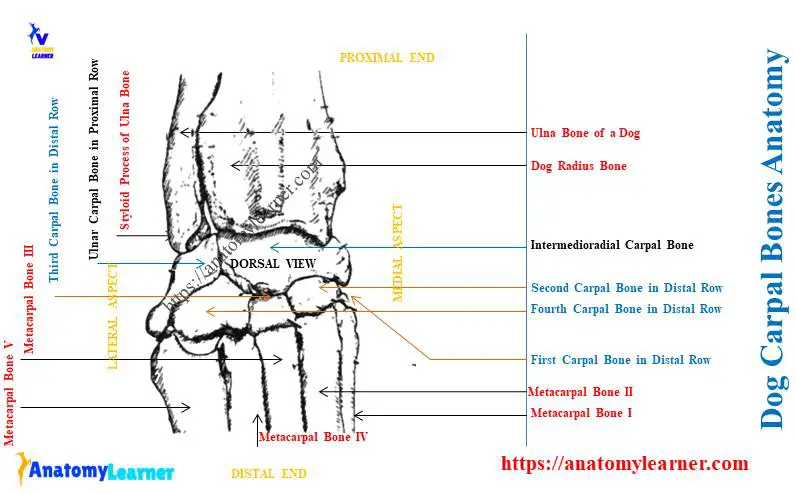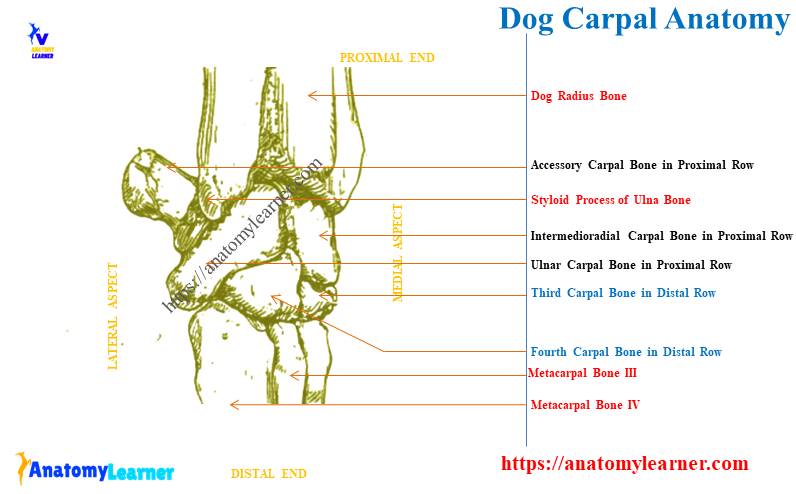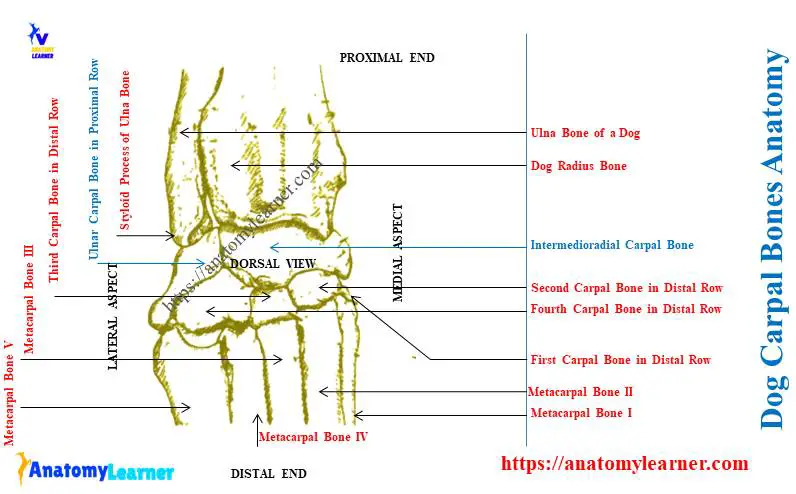The dog carpal anatomy includes seven short bones between the radius-ulna and metacarpals. Here, I will show you the osteological features of the carpus bones from the dog’s forelimb anatomy.
Quick overview: the dog carpus possesses seven (7) short bones arranged in two transverse rows. Here, the proximal row’s carpus bone (3 in number) joins with the distal extremities of the radius and ulna bones. In contrast, the distal row’s carpus articulates with the proximal end of five metacarpals.
After completing this article, you will confidently identify the proximal and distal rows of carpus bones from the dog’s forelimb. You will also understand the different features and articulation of dog carpus with other bones.
In the end, I will show the differences among the carpus of dogs, horses, cows, and pigs. You will get an idea of the variation in number, arrangement, and features of the carpus bones in various animals.
Okay, let’s get started to know the number, arrangement, and osteological features of dog carpal bones with a diagram.
Dog carpal bones anatomy
The carpal is an important component in the structure of a dog forepaw or manus. You will also find the metacarpals, phalanges, and specific sesamoid bones in the forepaw anatomy of a dog.
Here, the term – “carpal” means the bones, whereas the term “carpus” means the joint or articulation.
Let’s see the summary of the dog’s carpal bones from Table 1 –
| Dog carpal bone anatomy | Features |
| Number of the dog carpal | 7 (seven) |
| Arranged in rows | 2 rows Proximal row – have 3 carpals Distal row – have 4 carpals |
| Sesamoid bone | 1 (of adductor digit I longus) |
| Name of dog carpals (ossa carpi) | Proximal row – Intermediate + radius carpal (I+R), Ulnar carpal Accessory carpal In distal row – First carpal – carpale primum Second carpal – carpale secundum Third carpal – carpale tertium, and Fourth carpal – carpale quartum |
| Joints formation by carpals | Intercarpal joints Metacarpal joints, and Radio-carpal joints |
Thus, the carpal of a dog means –
- Seven carpal bones (ossa carpi), and
- Associated sesamoid bones,
Here, the diagram shows the different carpal bones from the dog’s manus. This helps you to understand the bony structure of the dog’s carpus.

Number of carpal bones in a dog
Dog owners and anatomy learners have a common question – how many carpal bones do dogs have?
Quick answer: you will find 7 carpal bones in the dog’s carpus arranged in two rows. These seven bones of the dog’s carpus form the dorsal convex transverse outline and concave palmar outline.
- Total carpal in a dog: 7,
- Proximal row carpal in a dog: 3, and
- Distal row carpal in a dog: 4;
In the proximal row of the carpal bone in a dog, you will find the below-mentioned 3 carpal bones –
- Intermediate plus radial carpal bone or intermedioradial carpal (medially),
- Ulnar carpal bone (laterally), and
- Accessory carpal bone (a palmar aspect of the ulnar carpal),
Again, the distal row of the dog carpal shows 4 bones – first, second, third, and fourth (Medial to lateral). Here, the dog carpus labeled diagram shows the arrangement of the dog’s proximal and distal row carpals.
Now, let’s see the anatomical name of the proximal and distal row’s carpal bones of a dog from Table 2 –
| Dog carpal bones | Anatomical name of dog carpals |
| Intermediate carpal | Carpi intermedioradiale |
| Ulnar carpal | Carpi ulnare |
| Accessory carpal | Carpi accessorium |
| First carpal | Carpale primum |
| Second carpal | Carpale secundum |
| Third carpal | Carpale tertium |
| Fourth carpal | Carpale quartum |
Now, you will learn the details description of these proximal and distal rows’ carpal bones with the diagrams.
The intermedioradial carpal bones of a dog
This bone represents the fusion of the intermediate carpal with radial and central carpals. You will find this intermedioradial carpal bone of a dog in the medial aspect of the proximal row.
Two larger surfaces are in the structure of a dog’s intermedioradial carpal bones – proximal and distal. Here, the proximal surface of the intermedioradial carpal articulates with the trochlea of the dog’s radius bone.
You will find a basic idea of the different bones of the fore and hind limbs (including the radius) from the below-mentioned article –
Again, the distal surface of the intermedioradial carpal bone has articulation with the proximal surface of 4 distal carpals. The laster surface of the intermedioradial carpal articulates with the ulnar carpal bones.
The transverse length of the dog’s intermedioradial carpal bone is larger than the width. Here, the dog’s intermedioradial carpal bone is found in the carpus-labeled diagram.

An ulnar carpal bone of a dog anatomy
This is the lateral carpal bone in the proximal row of the dog’s carpus. The shape of the dog’s ulnar carpal bone is almost similar to the intermedioradial carpal. But the ulnar carpal is smaller compared to the intermedioradial carpal bone.
The ulnar carpal of a dog also possesses various surfaces – lateral, medial, proximal, and distal. Here, the proximal surface of the ulnar carpal bone articulates with the distal ends of the radius and ulna bones.
The distal surface of the dog’s ulnar carpal bone articulates with the fourth carpal and the fifth metacarpal bone. You will also find the articular surface for the intermedioradial carpal bone on the medial aspect of the ulnar carpal.
The number and structure of the dog’s metacarpal bones differ from those of the ruminant metacarpals. You may get an idea of the differences between the dog’s and cow’s metacarpal bones in the below-mentioned article –
You will find two processes in the palmo-lateral aspect of the dog’s ulnar carpal bone –
- Small lateral process and
- Larger palmar process,
The accessory carpal bone and the fifth metatarsal bone articulates with the larger palmar process of the ulnar carpal. Again, the small lateral process is the separated parts from the carpal.
You will find a concave articular surface on the small lateral process for the styloid process of the dog’s ulna bone.
An accessory carpal bone of a dog
On the palmar aspect of the dog’s ulnar carpal, you will find the attachment of the accessory carpal. This is a small pyramidal shape carpal bone in the structure of the dog carpus anatomy.
You will find the apex and vertex in the feature of the dog’s accessory carpal bone. Here, the basal and free ends of this pyramidal rod shape accessory carpal show larger expansion.
You will find a saddle-shaped articular surface on the basal end of the accessory carpal bone. This articular area is designed for articulation with the ulnar carpal.
But, this area separates from the proximally directed area for the styloid process of the ulna bone. The distal free end of the accessory carpal bone is somewhat thicker than the proximal end.
Again, you will see an overhang portion in the distal free ends of the dog’s accessory carpal bone. This accessory carpal bone is not considered the true carpal bone in the dog.
Two flexor muscles of the dog’s forearm insert into this accessory carpal bone. The flexor carpi ulnaris and ulnar lateralis muscles of the dog forearm insert into the accessory carpal bone.
Now, you will learn the details of anatomical features of the distal row carpal bones from the dog forepaw.
The first carpal bone of a dog
This is the smallest carpal bone in the distal row of the dog carpus. The first carpal of a dog is a somewhat flattened bone that possesses various surfaces for articulation with the second carpal and metacarpal II and I.
This first carpal of a dog articulates with –
- Palmaromedial surface of the second carpal bone,
- The base of the metacarpal II bone,
You will also find the articulation of the first carpal bone of a dog with the intermedioradial carpal and metacarpal I. Here, the first carpal articulate proximally with the intermedioradial carpal bone.
Again, the distal end of the first carpal attaches with the proximal end of the metacarpal I.
Second carpal of canine
The second carpal of a dog is also small and possesses four different articular surfaces. You will find this dog’s second carpal bone has a wedge-shaped appearance.
This second carpal of the dog proximodistally compresses bone. You will see the articulations of this bone with the intermedioradial carpal, metacarpal II, third and first carpal bones of the carpus.
Let’s see the articulations of the second carpal of a dog in the followings bones –
- Intermedioradial carpal – the proximal end of the second carpal articulates with the intermedioradial carpal,
- Metacarpal II – the distal end of the second carpal articulates with metacarpal II,
- Third carpal – the lateral surface of the second carpal articulates with the third carpal bone, and
- First carpal – the medial surface of the second carpal joins with the first carpal bone,
Canine third carpal bone
The third carpal bone of the canine is somewhat larger than the second carpal. You will find a larger palmar projection in the structure of the canine third carpal bone.
This larger palmar projection of the third carpal bone articulates with the three middle metacarpal bones. Again, you will find various articulations of the canine third carpal bone with intermedioradial, second, and fourth carpal bones and the metacarpal bone III.
Let’s see how the third carpal bone makes articulation with other carpal and metacarpal bones –
- Proximally articulates with the intermedioradial carpal bone,
- Distal articulates with the metacarpal III bone,
- Laterally articulates with the fourth carpal bone and finally
- Medially articulates with the second carpal bone of the dog’s carpus,
Canine fourth carpal bone structure
The fourth carpal is the most prominent bone in the distal row of the dog’s carpus structure. This is the lateral most carpal of the distal row and represents the caudal enlargement.
You will see it as wedge-shaped in both dorsal and proximal views. The fourth carpal bone of a dog possesses 5 (five) articular surfaces on its body.
This largest carpal bone articulates with the metacarpal IV and V. Again; it articulates with the intermedioradial, ulnar, and third carpal bones.
Let’s see how the canine fourth carpal bone joins with the metacarpals and carpal bones of the forepaws –
- Proximomedially – it articulates with the intermedioradial carpal bone,
- Proximolaterally – it joins with the ulnar carpal bone,
- Distally – the fourth carpal articulates with the metacarpal IV and V, and finally
- Medially – it joins with the third carpal bone,
I hope you can understand the appearance and various surfaces of the fourth carpal bone of dogs.
An associated sesamoid bone of the dog’s carpus
You will also find the small bone in the structure of the dog carpus anatomy. This is a small radish seed-like structure in the carpus of a dog.
This small radish seed-like bone is known as the spherical sesamoid bone. You will find this small sesamoid bone in the tendon of insertion of the abductor digiti I longus muscle.
That means you will find it on the medial aspect of the proximal end of the first metacarpal bone.
Cow carpal anatomy labeled diagram
Now, I will show you the carpal bones from the dog forepaw labeled diagram. Here, I tried to identify all the proximal and distal row carpal bones from the diagram.
The lateral ulnar and accessory carpal bones from the proximal row are identified in the labeled diagram. Again, the medial larger intermedioradial carpal bone is also identified from the dog forepaw structure.
The dog manus labeled diagrams also identify the 4 carpal bones from the distal row. The first carpal is on the medial aspect, and the fourth carpal is on the lateral aspect of the distal row.
You will find more diagrams of the carpal bones (including all the other elements of the manus) on social media of anatomy learners. Or, you may see the video where I have discussed the forepaw anatomy (including carpus) of a dog.
Carpus and metacarpus of a dog
The term carpus also includes the joint formed by the carpal bones (that I have already discussed). It locates between the forearm and metacarpal of the dogs.
Again, the metacarpus refers to the region between the carpus and digits. You will find five metacarpal bones in the structure of the metacarpus of a dog.
But, the number of the metacarpal bone in one forelimb varies in the cow. You will find 2 larger metacarpal bones in a cow (fuses to form the single one).
Each metacarpal of a dog possesses a cylindrical body and two expanded ends or extremities. Here, the first metacarpal bone of a dog metacarpus is short and slender. But, the metacarpal II to V is the typical metacarpal bone that shows the ideal features.
Carpal bones of a pig
First, you may have the question – how many carpal bones do pigs have? In short, the pigs have 8 (eight) carpal bones in the structure of its forepaw.
Here, these eight carpal bones of a dog are also arranged in two rows. The proximal row shows 4 carpals – radial, intermedial, ulnar, and accessory (medial to lateral).
Again, the distal row of the carpal possesses 4 bones – first, second, third, and fourth (medial to lateral).
Carpal bones of horse
You will find the same number of carpal bones in the structure of a horse carpus. That means the horse possesses 7 (seven) carpal bones in the forepaw or manus and is arranged in two rows.
But, the proximal row of the carpal shows 4 bones – radial, intermediate, ulnar, and accessory. And the distal row of the horse carpal possesses 3 bones.
You will see the second, third, and fourth carpal bones in the distal row. Sometimes, you may find the first carpal bone in the horse carpus structure in a nodular form.
FAQs on dog carpal bones
Now, I will enlist the most commonly asked questions on the carpal bones of the dogs. You might know the details of these 7 carpal bones of a dog from my above discussion.
Let’s see the frequently asked questions on the canine carpal bone or carpus structure with their concise answer –
Where is the carpal on a dog?
Answer: carpal is the component of the manus of a dog. You will find the carpal between the forearm and metacarpal bones of the dog’s forelimb.
There are 14 carpal bones in the two forelimbs of a dog that contribute to the carpus.
What is the carpal bone of an animal?
Answer: carpal bone is the short bone in the forelimb of an animal. The number and appearance of the carpal bones vary in different animals.
You will find 6 carpal bones in ox, sheep, and goat. The horse and dog possess 7 carpal bones in their carpus. But the arrangements and appearance of these 7 carpal bones in a horse and dog vary.
Again, the pig and rabbit possess 8 carpal bones in their carpus anatomy. But, the arrangement of the eight carpal bones in a rabbit’s carpus is more complicated than these of the pigs.
What is the difference between a dog’s carpus and a metacarpus?
Answer: the dog’s carpus includes the seven short bones in the forelimb, whereas the metacarpus possesses the five miniature long bones. Here, the dog’s carpus forms between the forearm and the metacarpal.
Whereas the metacarpus forms in between the carpus and digits. But both carpus and metacarpus are the main components of the dog’s forepaw or manus.
Conclusion
So, the dog carpal anatomy possesses 7 short bones and associated sesamoid bones. Intermedioradial, ulnar, and accessory carpal bones are arranged in the proximal row of the dog’s carpus structure. The distal row carpal bones of a dog are comparatively small than these of the proximal row.
A great variation in the number and appearance of carpal bones is found in dogs, cows, horses, and pigs. But, the arrangement of these carpal bones (in two rows) are similar in various animals as you find in the dogs.

